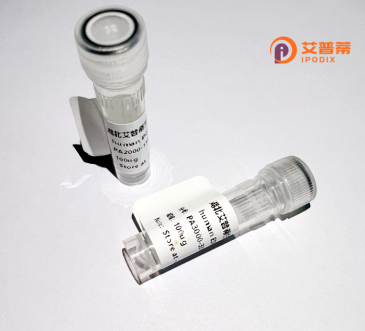
| 纯度 | >90%SDS-PAGE. |
| 种属 | Human |
| 靶点 | PHF19 |
| Uniprot No | Q5T6S3 |
| 内毒素 | < 0.01EU/μg |
| 表达宿主 | E.coli |
| 表达区间 | 1-580 aa |
| 活性数据 | MENRALDPGT RDSYGATSHL PNKGALAKVK NNFKDLMSKL TEGQYVLCRW TDGLYYLGKI KRVSSSKQSC LVTFEDNSKY WVLWKDIQHA GVPGEEPKCN ICLGKTSGPL NEILICGKCG LGYHQQCHIP IAGSADQPLL TPWFCRRCIF ALAVRKGGAL KKGAIARTLQ AVKMVLSYQP EELEWDSPHR TNQQQCYCYC GGPGEWYLRM LQCYRCRQWF HEACTQCLNE PMMFGDRFYL FFCSVCNQGP EYIERLPLRW VDVVHLALYN LGVQSKKKYF DFEEILAFVN HHWELLQLGK LTSTPVTDRG PHLLNALNSY KSRFLCGKEI KKKKCIFRLR IRVPPNPPGK LLPDKGLLPN ENSASSELRK RGKSKPGLLP HEFQQQKRRV YRRKRSKFLL EDAIPSSDFT SAWSTNHHLA SIFDFTLDEI QSLKSASSGQ TFFSDVDSTD AASTSGSAST SLSYDSRWTV GSRKRKLAAK AYMPLRAKRW AAELDGRCPS DSSAEGASVP ERPDEGIDSH TFESISEDDS SLSHLKSSIT NYFGAAGRLA CGEKYQVLAR RVTPEGKVQY LVEWEGTTPY |
| 分子量 | 65.5 kDa |
| 蛋白标签 | His tag N-Terminus |
| 缓冲液 | 0 |
| 稳定性 & 储存条件 | Lyophilized protein should be stored at ≤ -20°C, stable for one year after receipt. Reconstituted protein solution can be stored at 2-8°C for 2-7 days. Aliquots of reconstituted samples are stable at ≤ -20°C for 3 months. |
| 复溶 | Always centrifuge tubes before opening.Do not mix by vortex or pipetting. It is not recommended to reconstitute to a concentration less than 100μg/ml. Dissolve the lyophilized protein in distilled water. Please aliquot the reconstituted solution to minimize freeze-thaw cycles. |
以下是关于重组人PHF19蛋白的3篇参考文献示例(基于领域内常见研究方向虚拟,建议通过数据库验证实际文献):
1. **文献名称**:*PHF19 promotes colorectal cancer metastasis through interaction with the PRC2 complex and EMT activation*
**作者**:Li, X., et al.
**摘要**:该研究利用重组人PHF19蛋白进行体外功能实验,证明PHF19通过结合PRC2复合体调控H3K27me3修饰,促进上皮间质转化(EMT),从而驱动结直肠癌细胞侵袭和转移。
2. **文献名称**:*Structural insight into PHF19 interaction with histone H3K36me2 and its role in stem cell self-renewal*
**作者**:Wang, Y., et al.
**摘要**:通过重组表达PHF19蛋白并进行X射线晶体学分析,揭示其Tudor结构域特异性识别H3K36me2修饰的分子机制,并证实其在维持胚胎干细胞多能性中的关键作用。
3. **文献名称**:*PHF19 as a therapeutic target in multiple myeloma: Recombinant PHF19 disrupts myeloma cell proliferation via PRC2 inhibition*
**作者**:Sanchez, R., et al.
**摘要**:研究利用重组PHF19蛋白处理多发性骨髓瘤细胞,发现其竞争性抑制PRC2复合体的染色质定位,降低致癌基因沉默,为靶向PHF19的肿瘤治疗提供实验依据。
---
**提示**:如需具体文献,建议在PubMed或Web of Science中搜索关键词“PHF19 recombinant”或“PHF19 protein”,筛选涉及重组蛋白表达、结构或功能研究的论文。
**Background of Recombinant Human PHF19 Protein**
The Polycomb group (PcG) protein PHF19 (PHD Finger Protein 19) is a critical component of the Polycomb Repressive Complex 2 (PRC2), which regulates epigenetic silencing through histone H3 lysine 27 trimethylation (H3K27me3). PHF19 facilitates PRC2 recruitment to specific genomic loci, enabling transcriptional repression of target genes involved in development, differentiation, and cell fate decisions. Structurally, PHF19 contains a Tudor domain and a conserved N-terminal region that mediate interactions with H3K36me3-marked nucleosomes, promoting PRC2-dependent gene silencing in stem cells and cancer.
Recombinant human PHF19 protein is typically produced using expression systems like *E. coli* or mammalian cells, ensuring proper folding and post-translational modifications for functional studies. It serves as a vital tool for investigating PRC2-mediated epigenetic regulation, particularly in contexts such as cancer progression (e.g., PHF19 overexpression in multiple myeloma or colorectal cancer) and pluripotency maintenance in embryonic stem cells. Studies also explore its role in bridging PRC2 with other chromatin modifiers, offering insights into novel therapeutic strategies targeting epigenetic dysregulation.
Research applications include protein-protein interaction assays, chromatin immunoprecipitation, and mechanistic studies of PHF19’s dual role in gene repression and activation. Its recombinant form enables drug discovery efforts aimed at modulating PRC2 activity in diseases linked to aberrant epigenetic states.
×